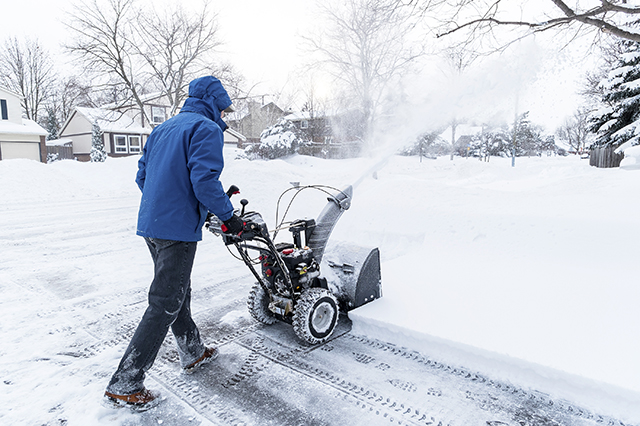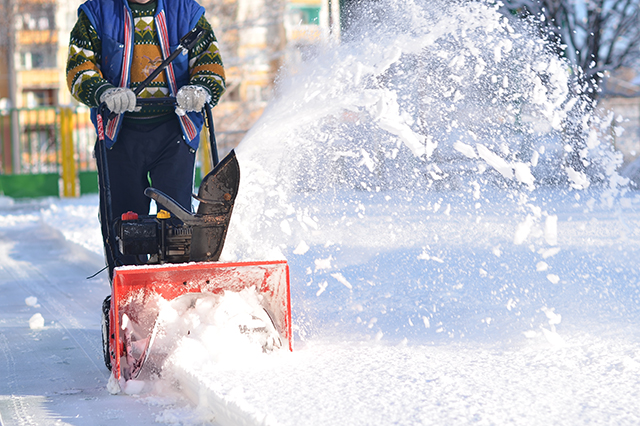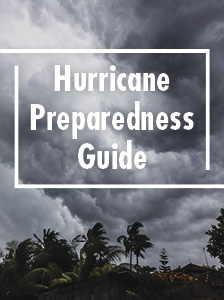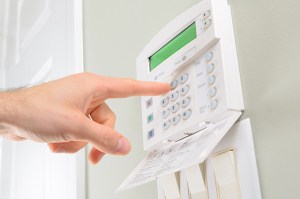There’s nothing like a blanket of fresh snow. There’s also nothing like a blanket of fresh snow between you, your sidewalk, your driveway and your car. While others may go for the more traditional route of shoveling out their driveways by hand, you may be the type that opts for the more efficient way of using a snow blower. Of course, a snow blower is a machine, and like all machines, there is necessary upkeep to keep it in working order. Snow blower maintenance is important to make sure that you can get out and get going even when the sky dumps several inches of snow overnight.
To help you with that, AAA has assembled a short guide to snow blowers and how to take care of them.
Getting to know your snow blower
First of all, what kind of snow blower do you have? You may use a single stage model, which uses rotating rubber paddles to collect and throw snow in one motion – hence the name single stage.
This model is best for clearing light snow. An electric single-stage snow blower is best for less than four inches and requires an outdoor power cord. A gas single-stage snow blower can clear up to eight inches of snow.
A two-stage model, which is also known as dual stage, uses serrated metal blades to cut through deeper snow, at least eight inches deep, and feed it into a chute. The chute is used to discharge the snow.
Sometimes a discharge chute on your snow blower may clog itself up. Please do not clear this out with your hands. You could seriously hurt yourself by sticking your hand near where the blades are stored.
First, turn off the snow blower and wait at least 10 seconds for the blades to stop running. Clear the chute using a clean-out tool, which may have come with the snow blower when you purchased it. Again, do not use your hands.

Getting started on snow blower maintenance
If your snow blower requires engine oil, check the oil levels after eight hours of use. Replace the oil after every 50 hours of use, or at least once per winter season. Fresh oil is golden brown, while older oil will darken.
When replacing oil, check your owner’s manual for the proper way to tip your snow blower. It varies on different models. Also, recycle used oil at engine repair shops or auto stores.
Be ready to replace the spark plug on your snow blower at least once a season as well. Even if it appears to be working, a spark plug will degrade over time. A weakened spark plug reduces engine performance and increases fuel consumption.
Inspecting your snow blower
Snow blower maintenance starts with inspecting the parts of your snow blower for wear, tear and dirt. For greasy and dirty areas, spray a degreaser, allow it to sit for 10 to 15 minutes, and then wipe it off with a clean cloth.
Check the pressure of your snow blower’s tires as well. Use a gauge to check the pressure if your tires look deflated. Lubricate your wheel bearings and other moving parts to make sure they are turning and moving smoothly.
Be sure to inspect the augers – the rotating blades or paddles – of your snow blower. On single-stage models, check the status of the rubber. If the paddles no longer touch the ground or you can see the metal underneath the rubber, it is time to replace the augers.
Finally, examine the fuel cap’s air vent holes. Replace the fuel cap if the holes are blocked by buildup or debris.
Let the machine cool before you store it anywhere.
When hen the season is over, clean the exterior of the machine and the engine and let them dry, then store your snow blower in a clean and dry area far away from corrosive materials. Follow the manufacturer’s instructions for fuel storage as well as keeping the snow blower lubricated. If your manufacturer says it is okay to keep the fuel in the fuel tank, be sure to store the snow blower away from any place where there could be fumes, a spark or a flame.
Do you practice routine snow blower maintenance? Tell us in the comments
AAA provides homeowners insurance, guidance and more to protect your home and keep it running smoothly. Talk to an agent today or visit AAA.com/Insurance to get a quote.
One Thought on “Snow Blower Maintenance Tips and Guide”
Leave A Comment
Comments are subject to moderation and may or may not be published at the editor’s discretion. Only comments that are relevant to the article and add value to the Your AAA community will be considered. Comments may be edited for clarity and length.

















I empty the fuel in the spring, start the blower and let it run until it burns the fuel in the bowl and shuts down. I remove the spark plug and put a small amount of clean motor oil in the spark plug hole and slowly pull the cord to coat the piston and piston walls then reinstall the spark plug before storing for the summer. in the fall I change the oil, check the belts, fill the fuel tank and install a new spark plug then give it a start.